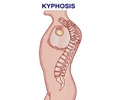A medical research shows that older patients who visited local ERs and had chest x-rays reveal unknown spinal fractures, were more apt to receive osteoporosis treatment.

Of those patients who weren't targeted with the intervention, only six per cent received follow-up treatment or testing for osteoporosis. When physicians were given educational material, the treatment or testing rate rocketed to 49 per cent. And when both the physicians and patients were informed, the rate climbed to 65 per cent of patients being treated or tested.
Faculty of Medicine & Dentistry researcher Sumit Majumdar was the principal investigator who led the study that was published in the peer-reviewed journal The American Journal of Medicine. It looked at patients over the age of 60 who visited two Edmonton emergency departments for various complaints and needed a chest x-ray, which incidentally revealed spinal fractures. One group of patients wasn't contacted for an intervention, only physicians were contacted in another group, and both physicians and their patients were contacted in a third group.
Family physicians targeted in the intervention received a one-page email, letter or fax from local doctors and nurses that explained osteoporosis treatment guidelines and recommendations. The same nurse phoned some patients to share the same information and answered patients' questions. These patients also received a pamphlet explaining the link between spinal fractures and osteoporosis.
"The information we provided was not new. But the fact it was linked to a specific patient and had specific advice, it acted as a reminder about what actions family doctors could take when they next saw that patient," says Majumdar.
"These fractures identified in chest x-rays are associated with a 20-fold increase of future fractures in people with osteoporosis – and these can be devastating fractures like fractures of the hip that can lead to nursing home admission or death," he says. "What was also concerning is that two-thirds of the patients in the study had a previously documented wrist or hip fracture before the x-ray was done, but they never received osteoporosis treatment."
When compared to the costs of the education intervention – $34 per physician and $42 per patient – "it's the equivalent of one month's supply of osteoporosis medication," says Majumdar.
Majumdar attributes this to the fallacy that "osteoporosis is considered a disease of older women." In fact, men have worse fractures and are more likely to die of hip fractures than women, said the researcher.
The research was funded by Knowledge Translation Canada, the Canadian Institutes of Health Research (CIHR) and Alberta Innovates – Health Solutions.
"This is both a research and a knowledge translation success story and CIHR would like to congratulate Dr. Majumdar on this important work," says Phillip Gardiner of the CIHR Institute of Musculoskeletal Health and Arthritis. "The health care costs associated with osteoporosis can be reduced and treatments improved when creative approaches like this are developed and implemented."
Majumdar hopes this educational intervention program could be a model for other conditions that could be identified in the ER, with follow-up care being co-ordinated by nurses or pharmacists.
Osteoporosis is a chronic and progressive condition that leads to fractures (typically of the upper extremity, spine or hip), acute and chronic pain, deformity, diminished quality of life, disability and loss of independence, nursing home admission and even death. It affects two million Canadians – about 25 per cent of women and 12 per cent of men over the age of 50.
A woman's lifetime risk of osteoporotic fracture is 40 to 50 per cent, while a man's risk is 12 to 20 per cent. In Canada, the annual cost of managing osteoporosis is estimated at $1 billion versus $750 million for heart failure or $600 million for asthma. Unless effective prevention strategies are implemented, the rates and costs of osteoporotic fractures are expected to double by 2025.
Source-Eurekalert
 MEDINDIA
MEDINDIA



 Email
Email










